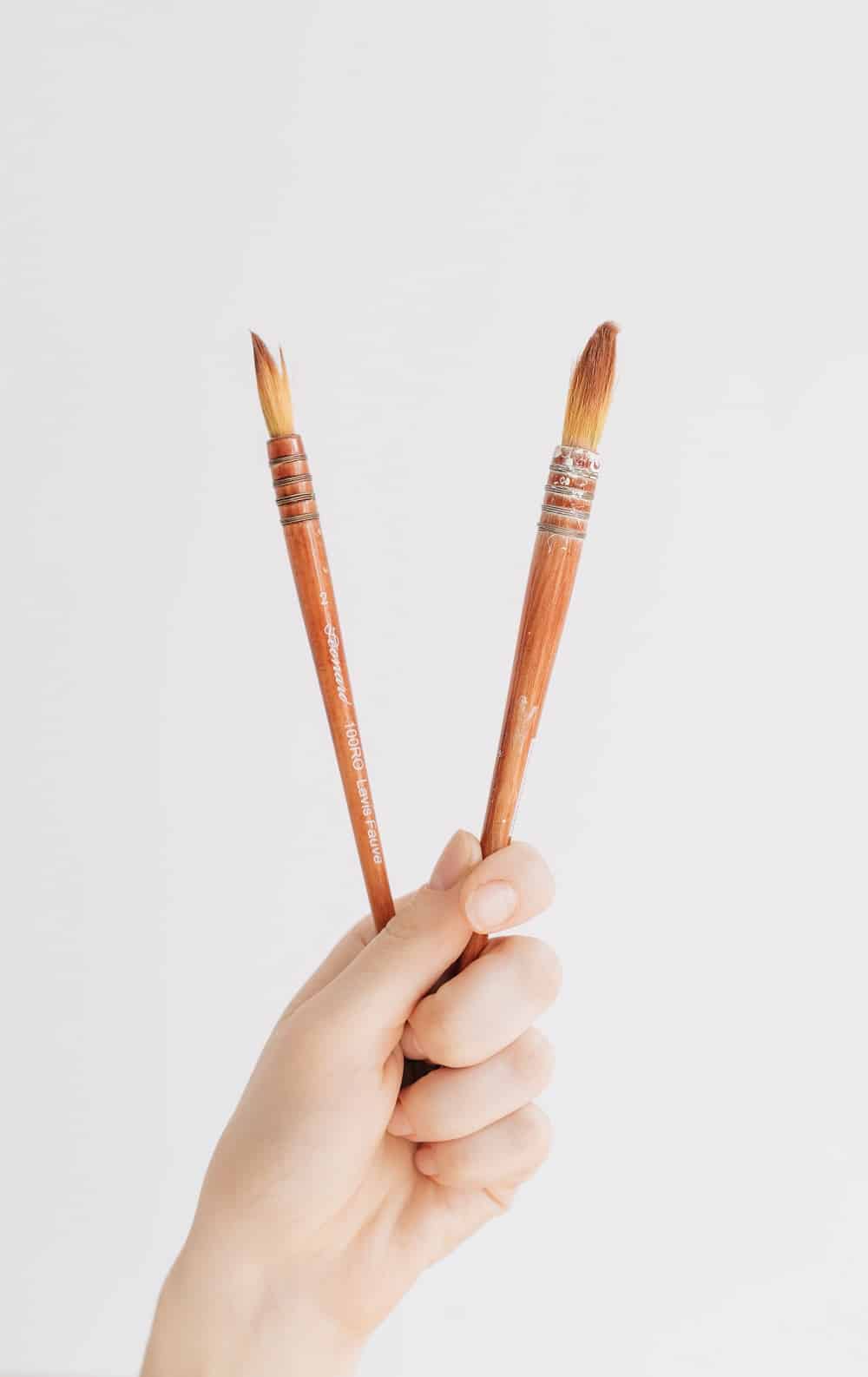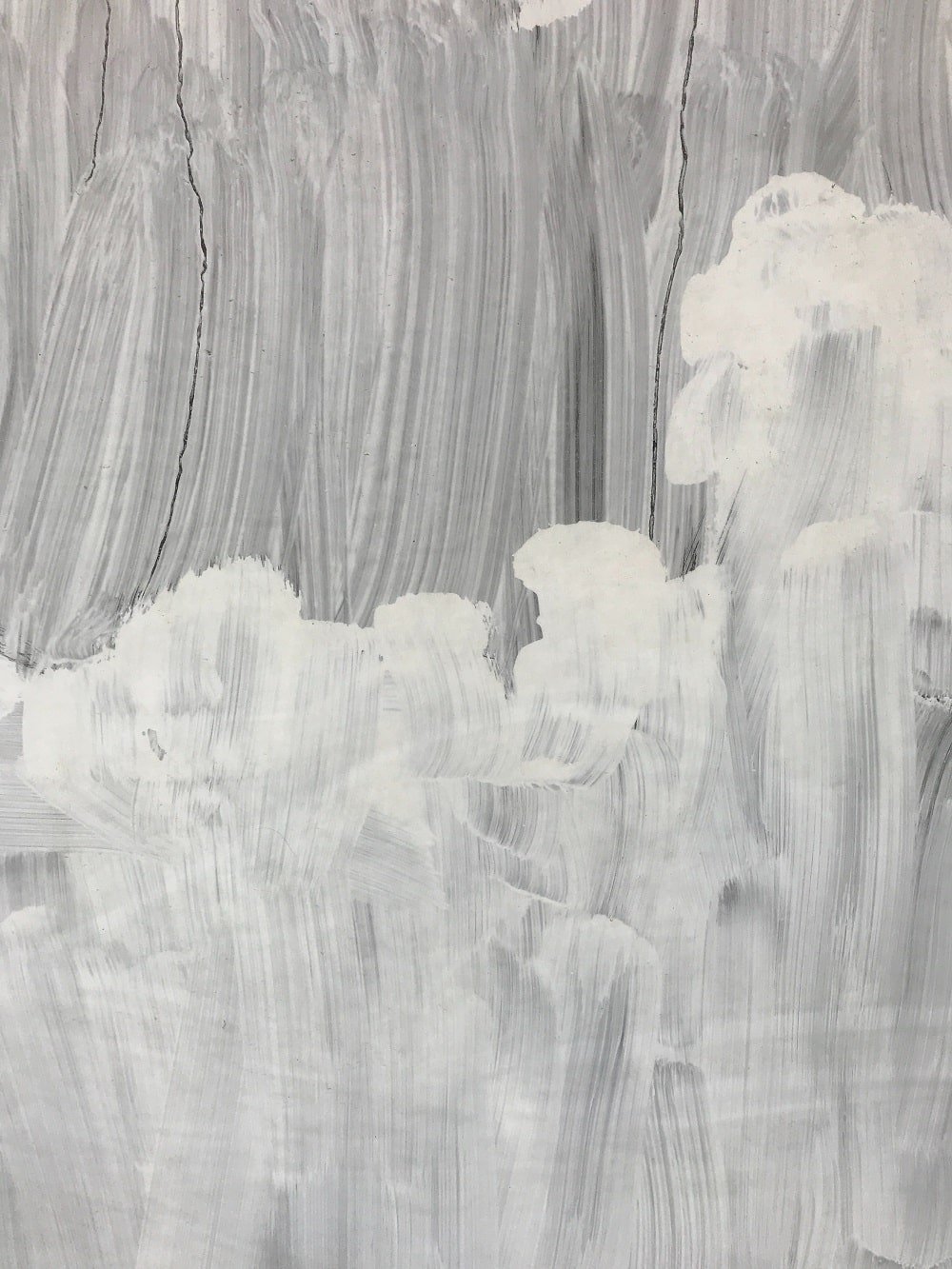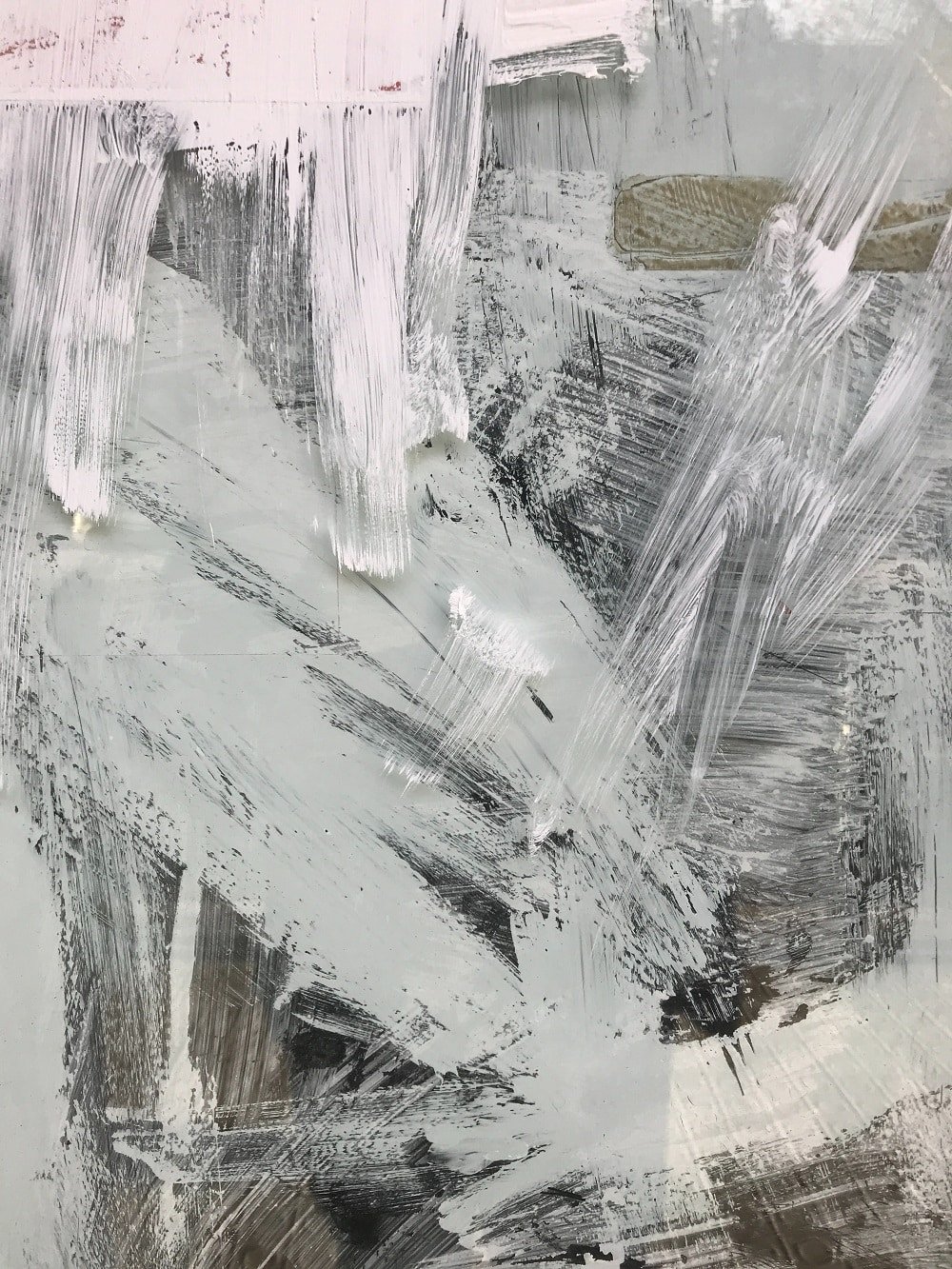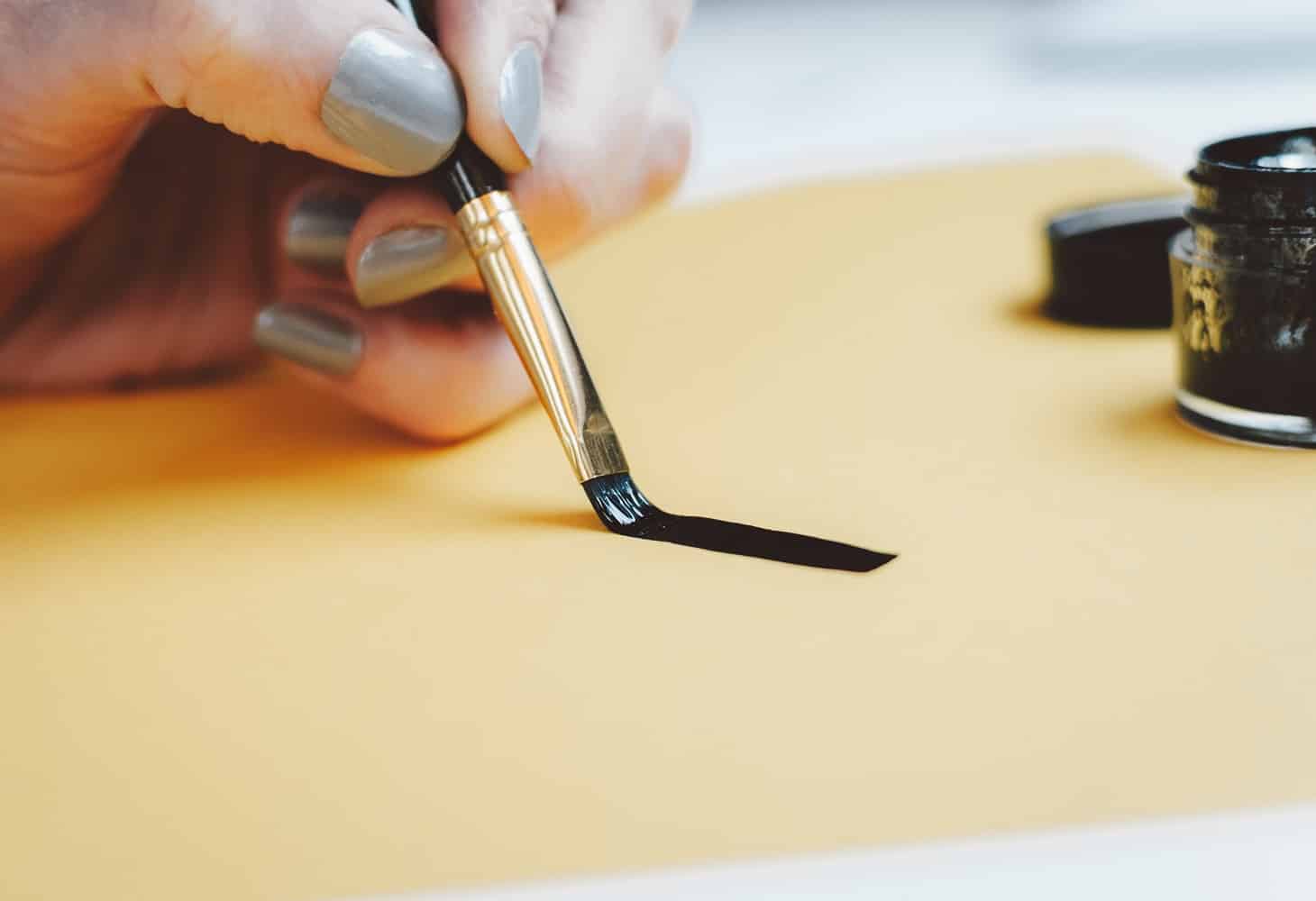Bumping the ceiling while painting or leaving the roller on the floor – we have all been there!
Mistakes are part of the learning process, and who among us can really say they have never painted outside the lines? After all, painting is a notoriously messy activity.
But with the three crucial P’s – prep, practice, and patience, the tricky process of painting smooth surfaces can be made possible. And all that without paying for a single class!
With that being said, rookie mistakes such as forgetting to tape up borders or leaning on a wet wall are easily avoidable problems; a little bit of common sense can solve them. On the other hand, painting without leaving brush strokes is a skill that takes time and preparation. Here’s how to go about it.
How To Paint Without Leaving Brush Strokes

Before you start practicing the correct brush technique, it’s essential to buy the right supplies and prepare the work surface. At the end of the day, the right type of paint and paint-brush, and the attention you give while prepping will decide the quality of the finished product.
Needless to say, research well before proceeding!
-
Preparing The Supplies
-
-
Type Of Paint
-
Regardless of whether you are working with chalk paint, oil paint, mineral paint, or latex paint, the brush technique remains the same. However, some paints are easier to work with than others.
Generally, paints with a matte finish or chalky texture are less prone to streaking because the thick layers conceal flaws more easily. At the same time, paints with a more extended drying period are a better option for preventing brush strokes.
Nevertheless, oil-based paints and latex paints are two of the most commonly used paints – of which the oil-based kind has a longer drying period. And although the oil-based formula has a more agreeable drying period and glossier finish, a paint conditioner can give latex paints a similar result, while also increasing the drying time.
However, it’s worth noting that oil-based paints get a bad rap because most formulae have a higher Volatile Organic Compound (VOC) level. In other words, they have a strong odor of fumes, which can be toxic in large amounts.
All things considered, oil-based paints can be used safely on smaller surfaces, such as cabinets and furniture, which don’t require a large quantity of paint. Moreover, the glass-like finish and durability of oil paints have served it well for all these years.
-
-
Type Of Paint Brush
-
Weigh your paint options, and move on to the most decisive question of all: What kind of paintbrush should you use?
Investing in a high-quality paint brush will take you a long way, to say the least. After all, you don’t want to find yourself picking out shedding fibers from a freshly painted surface. And not just limited to bristles – a reliable paintbrush will also hold paint better, preventing dripping.
In terms of material, you should pick brush bristles that are soft and quickly fan out. Generally, these are made up of animal hair, synthetic fibers, polyester, or a mix between polyester and nylon.
Natural bristles made of animal hair, such as ox hair paint brushes, are well-suited for oil paints. On the flip side, the water in water-based products like latex paints will get absorbed by these. For latex paint, synthetic brushes are a better option – when in doubt, read the label on the paintbrush!
-
Preparing The Surface
Whether you are working on a cabinet or a baseboard, the first step is to prime the surface. Once your primed surface is ready, it is time to sand it down and make it smooth for paint – best believe you don’t want to paint over a dusty or splintering surface!
Next, use 220 grit sandpaper to start sanding in the direction of the grains on the surface. After this, sand between grooves and any spots that you may have missed.
Then, use a dust brush to feather out all the wood dust – skipping this step will affect the final finish of your paint job. In addition, you can use a tack cloth to get rid of the sneaky little dust particles that may be hiding in tiny crevices.

Step-By-Step Painting Guide
With all your materials and work surface prepared, it is time to get into the tricky business of painting – without brush strokes, of course!
Step 1| Prepare The Paint
Prepare the paint by adding in the correct quantity of thinning agent or conditioner – that is, if you want to do so. Floetrol for latex paints and Penetrol for oil-based paints are two of the most well-received paint conditioners that do more than just provide a smoother finish.
Step 2| Dip The Paintbrush
Be brave, and dip your paintbrush into the bucket of paint.
Keep in mind that you don’t want too little paint on the brush. Neither should the product be dripping down the handle or on the floor. As a rule of thumb, the paint should cover the brush bristles halfway or less.
In other words, make sure that the paint stays around the tip of the brush and won’t run to the roots of the bristles. Clean the hairs before the paint dries and cakes up near the roots as this could hurt your brush technique.
To shake off the excess paint, don’t rub or wipe the brush against the bucket. Rather, slap it on the bucket walls for a more even layer. After this, you can make a paint stroke on some extra plywood or any other test surface.
If the paint stroke has noticeable brush marks, there can be two possibilities – too little paint or too much pressure while applying.
Step 3| Be Firm, But Not Too Firm
Perhaps, you have applied too much pressure while painting the surface. And you are now left with brush strokes or uneven swatches of paint.
Moreover, pressing the brush too hard will inadvertently lead to wastage of paint. This usually happens when a lot of product is used to make up and match the initial thick strokes.
With that being said, it is more advisable to correct the initial mistakes rather than trying to cover them up. For this, you may have to redo whatever work you have done till now – after all, we did warn that patience is vital!
So, patiently wait for the paint to dry completely; then, sand the area down until the surface feels smooth again. Paint over the mistakes, while paying attention to the pressure this time around!
Step 4| Follow A Direction
Whether you are working on a large wall or on smaller surfaces such as trims, it is crucial to paint in the same direction. To be on the safe side, paint towards the direction of the grain when working with wooden surfaces such as trims and cabinets.
On the other hand, it is recommended that the painting strategy for painting walls include paintbrushes and rollers. First, take a paintbrush and work on the corners and edges – painting alongside the tape with smooth and linear strokes.
Once the outer perimeter is dealt with, take a roller and paint from the ceiling and move downwards – making a “V” as you go. Remember not to lift the roller as you paint the “V” and trace it back one more time.
Continue doing this until the entire wall is covered. Wait for the paint to dry up completely before you add another layer. Remember that painting over a wet wall will leave an unevenly patchy and unattractive finish. At the same time, if you let the wall dry sufficiently, then a second layer will leave a deeper hue with a smooth finish.
Step 5| Find An Alternative
Apart from paintbrushes, you can surely use these steps with a paint roller as well – after all, paint rollers also leave streaks. Be that as it may, they are still a more convenient and less tricky option for dealing with walls.
However, paintbrushes are still suited for, at least, the outer perimeters of walls, and painting detailed woodwork or kitchen cabinets. At the same time, the market is flooded by spray guns that can take over these other jobs without the chances of brush strokes! To cut it short, the spray nozzle in spray guns dispels light mists of paint on surfaces to give an even and streak-free paint job with minimal effort.
Moreover, spray guns are ideal even for painting indoor and outdoor walls. And, they are not only reserved for professionals – some are sold as small hand-held tools!

Tips and Tricks
-
Use A Conditioner
When a paint conditioner like Floetrol or Penetrol is added, the drying time of the paint mixture is prolonged. Since it takes more time to cure, the painter has a longer working time – shrinking the chances of brush strokes forming.
Moreover, paint conditioners provide a glass-like glossy finish to paint jobs that make it look smooth, even, and professional. In fact, adding these will aid in preventing paint from sticking to the paintbrush!
However, remember to read the label on the conditioner. Accordingly, only apply the recommended quantity of the product to the paint. Adding too much will result in a drippy mixture which will decrease coverage area and spread too thin – an ideal environment for brush strokes to form.
-
Slap Off Excess Paint
Many beginners, and even seasoned painters, have the habit of wiping their paint brushes to remove extra paint. However, slapping the paintbrush against the side of the paint bucket is a better way to ensure that most of the product isn’t wiped off from the tip.
After all, you want to keep the brush bristles loaded with paint to avoid dry and bare bristles streaking across your walls and furniture!
-
Follow The Grain
In any painting project, following the same direction is essential to avoid dark patches and brush strokes. And, when working with wooden surfaces, in particular, follow the direction of the grain and paint towards it. Needless to say, this ensures a smooth finish.
-
Cut And Fill
Anytime you are painting, it’s a good practice to cut first – that is, work on the borders, corners, and edges before filling them in. When working on a large wall, you can work in about 2-foot increments at a time, instead of cutting the whole area first and painting in the middle.
-
Don’t Overbrush
Beginner painters often have the misconception that applying heavy pressure on the brush, or going over the same spot multiple times will produce thick layers. In reality, over-brushing spreads out the paint, and the thin layer becomes more susceptible to brush strokes.
Frequently Asked Questions
-
Should I Paint With A Brush Or A Roller?
Paintbrushes are perhaps the most popular and traditional tool for painting most surfaces, especially for DIYers. These are great for painting detailed furniture pieces and smaller areas on walls such as corners, edges, and borders.
On the other hand, incorrect brush technique, the wrong choice of brush and paint, and a poorly-prepared paint surface are just a few of the reasons that can cause streaking. Moreover, although they are considered to be more economical, brushes require more paint. So, opting for a roller when tackling larger surfaces might be a better idea.
At the same time, rollers are not streak-proof either. Despite providing thin and even layers, pressing on the roller too firmly may still cause uneven paint marks, which can be an eyesore. With that being said, it is advisable to paint in a “V” shape when working with rollers for maximum efficiency.
-
Should I Use Latex Paint Or Oil-Based Paints For Minimal Brush Strokes?
As a rule of thumb, paints with a longer drying time and matte finish provide better chances of preventing brush strokes. With that being said, oil-based paints have more of an edge as compared to latex paints.
But, this is not to say that high-quality latex paints cannot provide the same benefits. After all, the formula for latex paints is continuously developing to make them more durable. Moreover, paint conditioners like Floetrol slow down the drying time to match that of oil-based formulae, while also providing a polished finish.
At the end of the day, it all comes down to your skill level. And, of course, other factors such as the type of brush and the preparations of the surface that you are working with.
Final Words
It’s called a paint “job.” And although it can be fun at times, a professional-looking paint job requires focus, attention, patience, and lots of practice.
However, the good news is that a job well-done can give you polished, durable, and newer-looking cabinets, trims, and walls with no trace of brush strokes. The cherry on top is that you develop a new skill.
Not to mention how you will be saving all that money by never hiring a professional again. In fact, with this guide in hand (along with some hard work and patience), neighbors will soon be paying you to paint their homes!
Related Articles
How To Paint Aluminum [Step by Step]
10 Best Paint Primer For Drywall
How Long Should Primer Dry Before Painting
10 How to Remove Spray Paint from Concrete
How To Remove Spray Paint From Plastic
How Much Does It Cost To Paint A Car?
9 Best Paint Roller To Hide Paint Defects
7 Best Paint Brushes For Trim [Review & Buyer’s Guide]
7 Best Primers To Cover Dark Paint
13 Best Professional Airless Paint Sprayer
How Much Does A Maaco Paint Job Cost?
The 7 Best Paint Sprayers for Chalk Paint
13 Best Air Compressors | Buyer’s Guide and Reviews
Paint Sprayer Vs. Roller [All You Need to Know]
Learn How to Remove Paint From Brick
7 Best Cold Galvanizing Paints
7 Best Primers For Covering Red Paint



